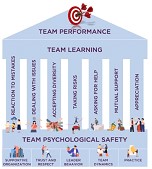Academic research has studied and validated psychological safety at the level of the individual [1] or the team [2]. But what about culture? It is obvious that people from different cultures interact or communicate differently. How does psychological safety then connect with the culture of these individuals?
Culture at the level of a country has been extensively studied by several scholars and the most commonly used model is probably the one Geert Hofstede developed in the 70s [3]. It has by and large stood the test of time, with years of data from nearly every country on the planet and continues to be a valid model to explore how people from different cultures behave differently.
How do we bridge the gap between the small scale of a team with 7 or 9 members and the notion of culture of an entire country with millions of nationals? Edgar Schein helps us make the connection by introducing the concept of “micro-culture” to describe the dynamics within a team [4]:
“Culture (including a team’s micro-culture) is a pattern of shared basic assumptions learned by a group as it solved its problems of external adaptation and internal integration, which has worked well enough to be considered valid and, therefore, to be taught to new members as the correct way to perceive, think and feel in relation to those problems”.

Team Psychological Safety and the 7 elements that constitute it – reaction to mistakes, dealing with issues, accepting diversity, taking risks, asking for help, mutual support and appreciation (see the TEAM.AS.ONE Team Psychological Safety model) – provide the perfect structure along which to evaluate and strengthen a team’s micro-culture.
Maybe there is someone in the team from Germany, someone else from Malaysia, and yet another team member from Brazil. All these team members obviously have different cultural backgrounds, but also different educational or professional experiences, family upbringings, religious or spiritual beliefs and personal values.
Each of these components contribute to how a member shows up and behaves with others. The Team Psychological Safety framework allows to operationalize how members interact with others when specific team-based routines occur. Maybe the person from Brazil sees appreciation differently from her colleague from Germany, and asking for help in a culture like Malaysia may be interpreted differently than in the USA. In the micro-culture that is the team, what counts is not abstract principles, but the concrete behaviors of each member in the team when they engage in interpersonal exchanges with others. It is more important to focus on how Marcus from Germany experiences and expresses appreciation, and how that is interpreted by Anna from Brazil, than drawing conclusions from the cultures of Germany or Brazil. “Asking for help” in a team’s micro-culture can be developed into a powerful team routine that is very different from how it would typically show up in the cultures of each of the team members.
The “internal integration” from Edgar Schein’s definition reflects exactly how a team deals with each of the 7 elements of team psychological safety. If mistakes are held against those who made them, or made fun of, or are used as a reason to stop discussion, the team’s micro-culture will evolve into one where team members hide their mistakes. If however the team has created a habit of sharing mistakes, using these to improve the processes and extract learning for future challenges, the team’s micro-culture develops into one where the mistakes become a driver to improve the team’s learning and performance.
The mantra “This is how things are done around here” resonates much better when it refers to the limited number of members in a team (6 or 8 or maybe 10) than when it supposedly reflects what happens amongst the 1000+ members of the organization. The Team Psychological Safety model allows to unwrap “this is how things are done around here” into the 7 concrete elements of team interactions. In some teams, certain of these elements are dealt with quite well because the team has shared experiences that lead to accepted and well-balanced norms around (for example) taking risks. But some other of the 7 elements could show up at the other end of the spectrum, either because the team has never had meaningful experiences related to these, or because those experiences were negative, and therefore never constructively “integrated” into the team’s micro-culture.
The Team Psychological Safety survey shows the team leader or facilitator how each of the 7 elements is perceived within the team. The team strengths can be celebrated, and the team challenges need to be addressed and appropriately “internally integrated” to strengthen the team’s micro-culture.
In summary, the Team Psychological Safety model and the certified facilitator program provide the framework, assessment and tools and techniques, to positively impact a team’s micro-culture, and set it up for enhanced team learning and improved team performance.
Peter Cauwelier, PhD
TEAM.AS.ONE
2024
- Kahn, W.A., Psychological Conditions of Personal Engagement and Disengagement at Work. The Academy of Management Journal, 1990. 33(4): p. 692-724.
- Edmondson, A.C., Psychological safety and learning behavior in work teams. Administrative Science Quarterly, 1999. 44(2): p. 350-383.
- Hofstede, G., G.J. Hofstede, and M. Minkov, Cultures and Organizations Software of the Mind. Vol. 3. 2010, New York: Mc Graw-Hill.
- Schein, E.H., Organizational Culture and Leadership. 4th ed. 2010, California, USA: Jossey-Bass.

